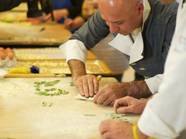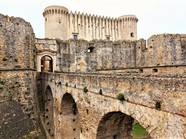Cognetti’s book is having worldwide success, and has already been translated into 38 languages. Throughout the evening, and Satyal’s questioning, we gradually became acquainted with Paolo Cognetti and the reasons for the intensity of his latest book.
Let’s start from the beginning!
The Eight Mountains – following a very contemporary Italian tradition made famous by Elena Ferrante – tells the story of a friendship between two young children – Pietro and Bruno – that endures despite the differences of their upbringing and of the paths their lives take. And Cognetti’s book has a surprising third character: the Mountain. Far from being only a background element, the mountain reveals itself as the real protagonist of the story: it binds together the lives of all the other characters, is has a special relationship with both Pietro and Bruno, and like a real character it changes throughout the course of the story. This book was meant to be a short story – a genre the author had previously experimented with – but, as he says, it expanded of its own accord.
Cognetti - whose physical appearance evokes a modern “mountaineer pirate” with his untamed red beard and two earrings in the left ear – explained that the Italian literary tradition is mainly urban, full of novels and stories set in cities. That’s why, in fact, he found inspiration for his book overseas, with American authors like Jack London, Melville and Hemingway, who are masters of the natural landscape tradition in literature. In the book, the Alps fill the role of the frontier, the great North of the American tradition. As Giulia Prati said during her introductory speech, despite the fact that Italy has an elongated shape and is surrounded by the sea, the mountains have been very important in its history: just think about their role during WWI and WWII. The Alps and the Himalayas are the protagonists of this novel, as well as two themes in the life of the writer: Cognetti lives between an apartment in Milan and a cabin 6,000 feet high in the mountains, and he has travelled several times to the Himalayas.
Other influences behind this book include Two of Two by Andrea De Carlo, The Chosen by Chaim Potok, Lessico Familiare by Natalia Ginzburg and Tom Sawyer and Huckleberry Finn by Mark Twain. Cognetti admitted that when he was a child he felt like a modern Tom Sawyer – a middle class educated kid – in search of his Huckleberry Finn.
The author shared the motives behind the choice of his title: The Eight Mountains. Throughout the time he was writing the book, he found himself “harassed” by the number eight. Before becoming a writer, Cognetti studied mathematics, and he has always been engaged with numbers. Therefore, he felt compelled to find a meaning behind the number eight, and behind the title of the book. He decided to interrogate the modern oracle, Google, which immediately linked this number to Buddhism and the Himalayas.
Before the end of the event, and the buffet generously offered by New Academia Publishing, Cognetti answered the crucial question about the worldwide success of his book. So here it is, according to him: friendship is a primordial and universal theme that everybody in the world experiences, and the fact that this particular friendship is set in the Alps – which have a central position in Europe – helped the book to become a sensation in Italy and abroad.
































